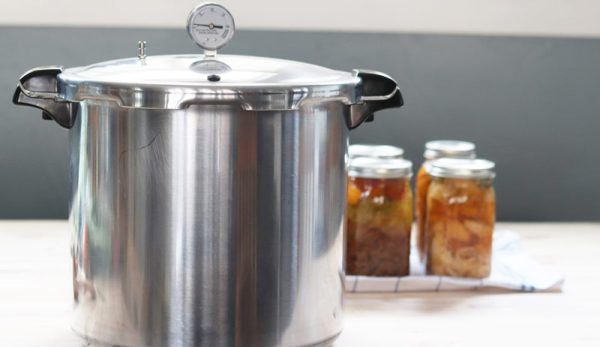
Recently I asked my Instagram friends if they had any hobbies or skills they hoped to try or learn this year, and many of them replied with “pressure canning.” Pressure canning is a method of food preservation used for low acid foods with a pH above 4.6, such as vegetables canned in water, meat and fish.
Many people have a fear of pressure canning because of the risk of botulism, which can be present in foods that is not properly preserved. However, if the proper procedures are followed and safe recipes are used, then it is truly a very safe method of home food preservation.
Pressure Canning Pot
A pressure canning pot with lid and rack that is approved for home canning (All American or Presto brands are recommended). See “notes” for more info.
Canning Jars
Standard canning jars made for home canning such as Ball and Kerr brands. The National Center for Home Food Preservation recommends using a brand new lid each time you can. However, rings and jars can be reused safely if they are not flawed in any way.
Read more: Can your pumpkin for anytime pumpkin pie puree.
Jar Lifter/Tongs
Jar lifters are made specifically for lifting jars in and out of the canner. They have a rubber or silicone coating over the part that grasps the jars to keep them from slipping as you maneuver them in and out of the canner.
Ladle and Funnel
A ladle, preferably one with a pour spout, makes for less mess when filling jars with brines, juices and other food. A funnel helps keep the counters a bit cleaner.
Trusted Recipes
Always preserve with safe recipes that are written based on tested USDA-approved methods for home food preservation. When pressure canning, higher altitudes will require an increase in the pressure. Reference the altitude adjustment charts included in your recipe books.
Read more: Check out these basic rules for canning meat.
Notes
When pressure canning, if the pressure ever drops below the required level, turn the heat back up to the target pressure and reset the timer for the full processing time. Even if the pressure drops at the end of the directed time, you must start completely over, get to the target pressure once again and reprocess for full time per the recipe.
When using pressure canners with dial gauges, remember to check the gauge annually for accuracy. Dial gauges can usually be checked at the local hardware store, or local extension office. Otherwise, you can send the gauge to the manufacturer for an inspection (varies by brand). Weighted gauges do not need to be tested.
Before pressure canning, also check the control valve or petcock and steam pressure gauge to make sure the steam can vent and clean it out if need be. Additionally, always remember to inspect the rubber seal to check for damage, stretching or shrinkage. Replace if need be.
Before storing away: Always wash off the jars after they have completely cooled and sealed, remove the rings, and be sure to label and date them.




